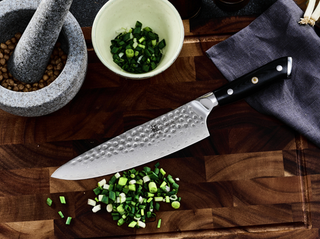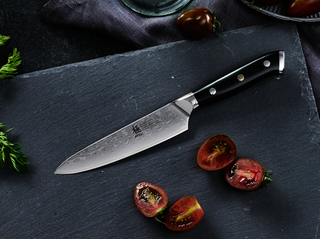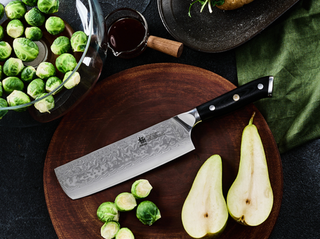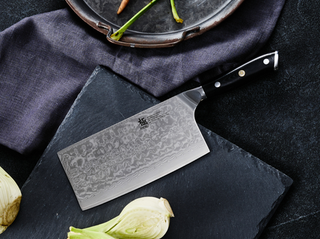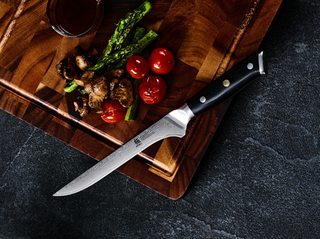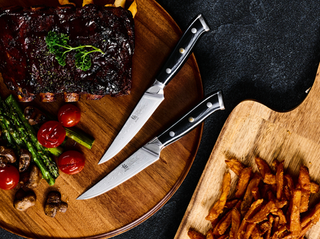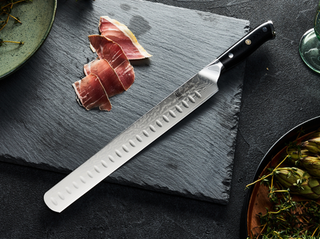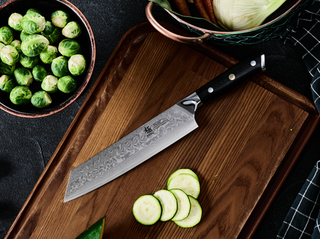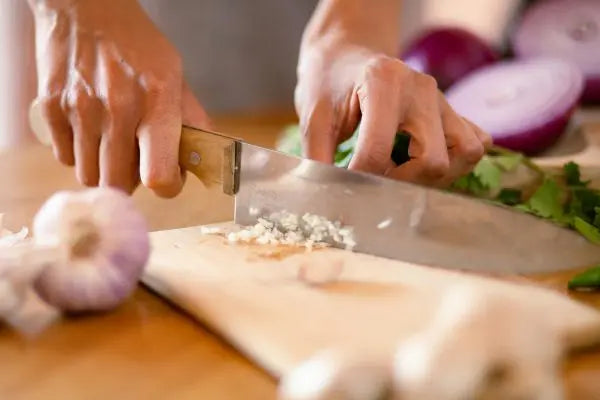Learning how to hold your knife properly is a crucial task that you must dedicate yourself to, even if you are “just a home chef”. The right grip is the foundation for safe, efficient, and skilful cutting.
Also, holding a knife properly allows you to make the most out of your knives: even the sharpest Japanese gyuto or Nakiri blade won’t perform at its best if you’re not holding it properly.

What is the Proper Way to Hold a Knife?
For most people, the best and most proper way to hold a knife is the pinch grip. It makes good use of your thumb (for solidity), and gives the best combination of control, balance, and precision.
However, depending on your level of experience with knives (beginner vs pro), the size of the knife in question, and the use of the knife, you can also opt for a handle grip, a fingertip grip, a hammer grip, a thumb-on-spine grip, or even a palm-on-blade grip.
- The handle grip is commonly believed to be the best way to hold a knife for beginners. It feels very natural and comfortable, and is arguably the safest way to hold a knife.
- The fingertip grip or pairing grip is generally considered to be the best way to hold a small knife. It mostly makes use of the fingers, which allows for a mix of grip strength and manoeuvrability, making it great for precision cuts.
- The saber or hammer grip is the proper way to hold a heavier knife for a task that needs power. A good example is when you are holding a cleaver knife to break open a (often younger)coconut.
All in all, the pinch grip is the most popular way to hold a knife, and it is a must-learn. Then you can also proceed to master the fingertip grip and hammer grip for tasks that require complexity or power, respectively.
Top 6 Common Ways to Hold a Knife
1. The Pinch Grip (The Go-To Everyday Grip)
The pinch grip is a way to hold a knife such that the thumb and index finger control the blade for precision, while the remaining three fingers grip the handle for firmness and power.
It is the grip most chefs swear by because it offers balance, control, and precision for the majority of every task.

Here’s how to hold a knife in a pinch grip:
- Place your thumb on one side of the blade, just above the handle (the bolster area if your knife has one).
- Rest the side of your index finger on the opposite side of the blade.
- Wrap your remaining three fingers around the handle.
The pinch grip is best for everyday slicing, dicing, and chopping, and it matches a wide variety of knife shapes and styles, including, but not limited to, the following:
- Gyuto (chef’s knife)
- Santoku Knives
- Nakiri knives (for vegetables and more).
2. The Handle Grip (The Beginner-Friendly Way)
The handle grip is the way of holding a knife that is most natural and comfortable for beginners: it involves the use of four fingers for a tight grip and the thumb for precision.

How to hold a knife in a handle grip.
- Wrap all four fingers around the handle.
- Rest your thumb comfortably on the top or side of the handle.
The only setback with the handle grip is that it sacrifices precision for stability, safety, and simplicity.
The handle grip is the proper way to hold a knife if you are a beginner, new to Japanese knives, or for chopping tasks. It works well with most knives, but especially deba knives (for breaking down fish) or sturdier blades when you need power.
3. The Fingertip Grip( For Utmost Precision)
The fingertip grip is the way to hold knives that are small and require small, controlled grips. This method makes the most use of your fingertips and gives you the precision you need when working with delicate ingredients.
Here's how to hold a knife in the handle grip:
- Hold the handle close to the blade with just your fingertips.
- Optionally, rest your index finger lightly on the spine for guidance.
The fingertip grip is best for delicate cutting tasks like peeling, trimming, or decorative cuts, and it works perfectly for knives with small blades like paring knives and petty knives.
4. The Saber (Hammer) Grip (The Power Grip)
The saber grip is the proper way to hold a knife when you are using a larger knife for a task that needs power. It involves the use of the fist and your thumb for added force.
- Wrap your hand around the handle in a fist.
- Place your thumb on top of the handle for added force.

The hammer grip is best for tasks like splitting squash and cutting through dense roots, which are normally best accomplished with cleaver-style knives.
5. Thumb-on-Spine Grip (For Push Cutting)
The thumb-on-spine grip is a variation of the pinch grip, but with more power for cutting through tough foods and items. Transitioning to a thumb-on-spine grip is a way to strengthen your pinch grip because it involves executing a pushing movement, which gives it more stability.
- Place your thumb gently on the spine of the blade.
- Support with your index finger pinching the side.
- Push downward and forward in smooth motions.
It is best for firmer vegetables like cabbage or potatoes, and it works best with a santoku or nakiri, which excel at push cutting.
6. Palm-on-Blade (For Crushing, Not Cutting)
The palm-on-blade method is the best way to hold a knife when you need to use the side of the blade to smash food items (like garlic) or to flatten ginger.
- Lay the knife flat over the food item.
- Press down firmly with the heel of your palm on the spine or flat (never the sharp edge!).
The palm-on-blade method works for garlic, ginger, or prepping aromatics. A flat-sided gyuto or santoku works beautifully here.

How to Hold a Chef's Knife
There are two main ways to hold a chef’s knife: the pinch grip and the handle grip. Which of the two you choose depends on your level of familiarity with a chef’s knife and how much precision is required for the cutting task you have at hand.
Holding a Chef’s Knife: Pinch Grip vs. Handle Grip
The pinch grip provides maximum control and balance, and it is normally regarded as the more “professional” way to hold a chef’s knife. It is the way to hold a chef's knife if you are not a beginner, and for cutting tasks, like chopping, slicing, dicing, or mincing, that require some precision.
The handle grip is the safer and more beginner-friendly way to hold a chef’s knife. It is the best way to hold a chef’s knife if you are a beginner and engaged in less complex cutting tasks like chopping some fruit or veggies.

Final Thoughts on The Best Ways to Hold a Knife
Again, the pinch grip is the way to hold a knife: it works for a variety of tasks and matches a wide variety of blade types, sizes, and shapes. But do not be limited in your options when it comes to knife-holding techniques.
- Use the pinch grip as your everyday foundation.
- Switch to the handle grip or saber grip when you need power.
- Bring out the fingertip grip for fine work.
- Don’t forget the claw on your guiding hand- it’s your built-in safety shield.
Remember that your sharp Japanese knives are designed to do the work for you. With the right grip, you’ll cut faster, cleaner, and safer, and your cooking becomes a lot more enjoyable.
